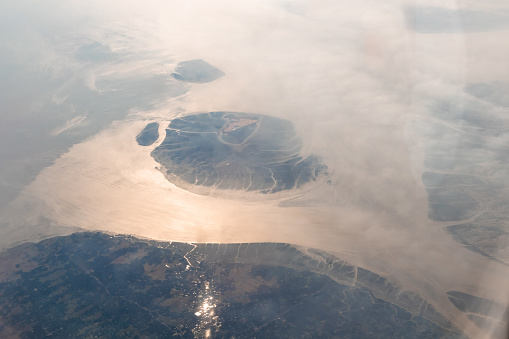Majuli is a large river island in the middle of the Brahmaputra River in Assam, India, and a newly formed district of Assam. On 27 June 2016, Majuli became the first river island district in India. Majuli is dominated by Mahapurusha Vaishnavism and Satriya culture with the Satras started by Mahapurush Srimanta Sankardev and Madhavdev. Majuli previously had an area of 1,250 square kilometers (483 square miles), but in 2001 it increased to 1,250 square kilometers (163 square miles) due to erosion. The area of Majuli is shrinking as the extent of the rivers surrounding it increases.
The island is formed by the Brahmaputra River in the south and the Sovansiri River in the north. Majuli can be reached by ferry from Jorhat city in Assam. The island is located about 200 km east of Guwahati, the capital of Assam.
History of Majuli
Before Majuli took the shape of a river island, the area between the Dihing and Brahmaputra was called Majali or Majali. The origin of the name "Majuli" is shown by the literary scholar Atul Chandra Hazarika as "Ma"+"Juli"= Majuli where "Ma= Ma Lakshmi" and "Juli= Jolonga/Bharal" There are many different types of characters in the film, but the most important one is the character of Majuli Nakul Chandra Bhuyan in his brief history of Bar Bhuyan mentions that the peninsula of Majuli took the shape of a river island during the reign of His Majesty Jaidhwaj Singh. Dr. JP Wade used the term Majuli in the eighteenth century. It is 160 British miles long and 60 British miles wide. According to the Gazetteer of Bengal and North East India, in 1901, Majuli had an area of 485 square miles.
Geographical Information of Majuli
Majuli is located in the north of Jorhat district of Assam (India) at 26° 48′ to 27° 12′ north latitude and 93° 39′ to 94° 35′ longitudes. The Majuli plain is shaped like licorice fruit. Majuli once had a geographical area of 1250 sq km but in 2012 it has narrowed to 508°13 sq km due to erosion of the Brahmaputra It is bordered by Lakhimpur and Dhemaji districts of Assam to the north, Jorhat to the south, Sibsagar district to the east and Golaghat and Sonitpur districts to the west.
Climate of Majuli
The climate of Majuli is known as the monsoon climate. Climatologically, the climate of Majuli is called subtropical monsoon climate. These seasonal air currents are caused by pressure changes due to seasonal temperature changes. The climate of Majuli is generally hot and dry. In winter, rainfall and temperature decrease, and cold prevalence increases. The temperature ranges from 22° to 34°C in summer and 10° to 12°C in winter. Majuli receives 200 to 300 cm of rainfall with regular monsoon winds.
Demographics of Majuli
As of 2011, the current population of Majuli is 140,0 Majuli is demographically mixed, with people of different ethnic groups living here There are many tribes in the area, including the Missing tribes, the Scheduled Castes, the Sonwal Kacharis, and the Debris, as well as some Bengali, Hindu and Nepali communities
culture of Majuli
Majuli is very rich in the folk culture of India There are many different ethnic groups in Majuli. There are many different types of characters in the film, but the most important one is the character of the heroine Satriya Culture is the main aspect of Majuli
Transportation of Majuli
Majuli is accessible from both Jorhat and Laxmipur in Assam, India There are many places to visit in Jorhat, including the Nimati Ghat on the outskirts of the city From Nimati, you can reach the beaches of Majuli like Kamalabari, Dakshinpat, Chumaimari, Oflamukh, Shalmara, Phulni (Bagariguri) etc The ferries also have the facility to cross light vehicles besides passengers There are two crossings from Laxmipur, Luit, and Khablu There is another route to Majuli via Bihpuria in Laxmipur. It is relatively easy.
Events and institutions Of Majuli
There are many different types of ceremonies and institutions in Majuli. In the 15th century, Mahapurush Sankardeva established the first satra at Dhuwahat-Belguri in Majuli and gave a distinct dimension to Assamese culture and devotional religion. There are many examples of these characters in the books of the Kacharis. He then left Bishwanath and stayed at several places and finally established a satra at Dhuwahat-Belguri in Majuli. The historic Belguri Satra of the Mahapurusha was washed away by the Brahmaputra in the monsoon season of 1837 and later moved to Kachikata in Lakhimpur. The Satras are the lifeblood of the Assamese society and are the birthplace of the Vaishnava culture of Assam. The satras of Assam are the carriers of the devotional movement. Although the word satra is used in various senses, Mahapurusha Sankaradeva established satras for the introduction, spread, and dissemination of Bhiktadharma. The role of the four Satras of Majuli has been specially recognized. There are four satras, Auniati, Kamalabari, Garhmur, and Dakshinpat Satras, which occupy a high place in Assamese society.






0 Comments